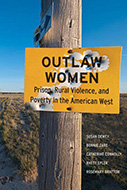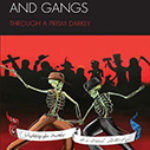Outlaw Women: Prison, Rural Violence, and Poverty in the American West

Authors: Susan Dewey, Bonnie Zare, Catherine Connolly, Rhett Epler, & Rosemary Bratton
Publisher: New York University Press, 2019. 271 pages
Reviewers: Ariel Booker & Vanessa A. Massaro (corresponding author) ǀ November 2021
Outlaw Women: Prison, Rural Violence, and Poverty in the American West offers a much needed window into the experiences of incarceration for women in rural areas. The book’s insights, drawn from in-depth qualitative research, inform scholarship of rurality, gender and gender violence, and mass incarceration. Outlaw Women tells the story and experiences of incarcerated women in rural areas and reveals how location can reinforce gendered violence. The books’ scene, rural Wyoming, brings to the fore two generally underexplored compounding factors of mass incarceration: rural poverty and gender. In so doing, the book draws on the tradition of qualitative criminology to inform both rural and feminist criminological scholarship.
Outlaw Women takes a deeper look into how addiction, mental health, intimate partner violence, reentry, and gendered components of economic crime all take shape in the rural landscape of Wyoming. To do so, the authors conducted countless interviews with women who were at different points of the incarceration process –some were still incarcerated at Wyoming’s only prison for women, while some were on parole. The interviews were compiled to create five composite characters that embodied the central issues found during the interviews. The use of composite characters allowed the authors’ creative freedom to develop “points emphasized to us by the women in interview transcripts or observations” while still maintaining the confidentiality of all research participants (34). The use of composite characters also enabled the authors to provide an in-depth examination of the women’s lives before, during and for some after prison. This facilitates a dramatized readability entwined with scholarly analysis that will surely engage a wide, non-expert audience.
The utilization of composite characters was the author’s best methodological tool to address the insular nature of the community, and the unique ease with which rural participants may be identified. This method, however, raises some additional questions for any research that continues to incorporate rural experiences. First, the characters are drawn from a large number of interviews (71 total) which is quite a bit to aggregate. The book would have benefited from the authors taking opportunities throughout the text to ground the composite characters in the broader interview findings by adding tables or discussing the interview coding that produced the characters’ representative themes. The authors effectively created characters that could appeal to undergraduate student readers and a policy audience, but the book could have used, at minimum, an appendix with more detail about the interviewees, coding and findings. In addition, the authors have embedded these histories with descriptions of the prison and of the limited programming offered there. The use of composite characters also runs the risk of losing the voices of the individual participants.
The book offers humanistic insights into the four central themes that compose the architecture of gendered violence: “addiction and compromised mental health, poverty, fraught relationships, and felony-related discrimination” (p. 42). In their examination of each of these themes, the authors highlight the unique positionality and experiences of rural women, and link those to larger deficiencies in social service provisioning. In their discussion of addiction and mental health, the authors demonstrate the role these play in incarcerated women’s experiences, noting there are limited treatment services with qualified individuals for women struggling with addiction and mental health issues. And when treatment services exist, there is often a waitlist, a significant cost involved, and/or an absence of anonymity that makes women unwilling to receive help due to the stigmatization (see pages 140-144). Similarly, in examining intimate partner violence, the authors relate the complex ties to mental health, poverty and the rural environment. They demonstrate that intimate partner violence occurs in conjunction with gendered norms particular to the geographic context. These troubles are similarly exacerbated by the lack of available services and the ostracization that comes with receiving help. A study done in rural Pennsylvania found that “hetero-patriarchal gender norms, limited education, economic dependence on an abuser, low self-esteem, and concerns about privacy” are the key reasons why rural women do not seek assistance (140).
There is also a wide gender discrepancy that exists between men and women going through the reentry process. Even though Wyoming uses a supposedly gender-neutral approach to help men and women reentering society, it is not neutral in outcome. There needs to be more adaptation of the programs available to meet the unique needs of women who are released from prison. The authors found that women judge their reentry success based on their relationships with their children, intimate partners, and family, and it is the success of those relationships that will determine if someone will return to prison. Additionally, there is a pay gap that exists between men and women, particularly in a rural setting, which is exacerbated for women with felony convictions. All of these central themes come together to create the authors’ overarching conclusion that the architecture of gendered violence is the primary pathway to incarceration, and that in order to successfully dismantle this architecture in Wyoming, there must be community solutions in place to address the needs of women. The authors successfully make their case while reinvigorating an understanding of the agency of incarcerated women – the authors make clear that women are not simply the victims of criminal men.
This book makes a major contribution to scholarship on incarcerated women in that the majority of the work on mass incarceration and women is focused on an urban context. Outlaw Women is focused on highlighting the experiences and perspectives of women who are traditionally ignored and overlooked in mainstream research. Additionally, the book highlights new policies that should be implemented in women’s prisons in rural settings. The book illustrates the gaps that exist in programming in Wyoming’s women’s prison, and argues that if there were more programs led by qualified individuals, the women would get more from the program and would be able to better themselves. Overall, Outlaw Women: Prison, Rural Violence, and Poverty in the American West addresses a much-needed area within the topic of mass incarceration, and highlights findings related to women’s incarceration and experiences in a rural setting in particular.
Ariel Booker is a 2021 graduate of Bucknell University
Vanessa A. Massaro is an Assistant Professor in the Geography Department at Bucknell University


